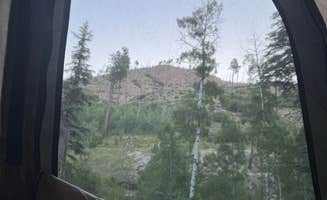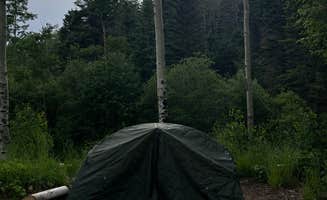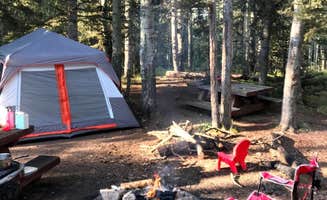The Santa Fe National Forest near Ribera offers primitive tent camping at elevations between 7,000-9,000 feet in the Pecos Wilderness area. Most tent sites require high-clearance vehicles to access forest roads that become challenging after rain. Temperatures drop significantly at night even during summer months, with frost possible in spring and fall, requiring campers to pack appropriate cold-weather gear regardless of season.
What to do
Fishing at multiple creeks: The area features several fishing spots where anglers catch trout in mountain streams. At Cow Creek Dispersed Camping Area, campers note "it's right along a creek where you can fly fish" and the area has "fresh water source, fire pit ring, room for 3 vehicles near camp."
Winter camping options: Unlike many wilderness areas, some campgrounds remain accessible year-round. At Big Tesuque Campground, winter visitors find "Road is paved all the way and regularly plowed during the cold seasons" making it "easily accessible, even in two feet of snow."
Alpine hiking from trailheads: Several campgrounds serve as starting points for wilderness trails. Winsor Ridge Trailhead camping offers access to a trail that "runs from the Pecos, over the mountain and into Santa Fe" though campers should note there are "lots of flies at the trail head" during monsoon season.
What campers like
Creek-side camping: Many campers appreciate the sound of water while sleeping. At Aspen Basin Campground, "there's a river that runs right through camp which was a bonus for us!" The streams provide both ambiance and practical benefits as "nice babbling brook alongside campsites, fun for kids to play in (COLD, but shallow), and makes for great white noise."
Privacy between sites: Despite being established campgrounds, many offer separation between campers. Cow Creek's "8 campsites are distributed along the forest road" though each is "no more than 10 feet from the road," providing minimal but functional privacy.
Seasonal color changes: Fall brings spectacular foliage viewing opportunities. One camper at Cow Creek noted "it was a longer drive out there than expected, but there's a sign that lets you know your in the National forest and out of peoples private property. You probably want 4WD because the road was rough, but definitely worth it with the fall colors!"
What you should know
Access road conditions: Many sites require navigating unpaved forest roads. For Trampas Trailhead Campground, "Access is either from FR 207, a well-maintained dirt road, or FR 639 which requires high clearance, good shocks, and would be difficult after rains because of some muddy areas."
Limited site availability: Most campgrounds fill quickly during peak seasons. Cowles Campground has no reservation system and "the area was already pretty busy Friday at noon when we arrived. We found 4 sites open when we arrived and the campground was full before dark. People need to be out of their space by 2."
Tree damage from fires: Some camping areas show evidence of past wildfires. At Cow Creek, "The forest itself has taken some extensive damage from fire and I'm guessing drought. It is beginning to repair itself, but may take decades to get back to its former glory. Dead trees standing and fallen, dot the hills."
Tips for camping with families
Kid-friendly water features: Several sites offer safe water play areas for children. At Cowles Campground, "A short walk takes you to the fishing ponds (one specifically for kids and disabled folks) which were really cool for the kids." Though note the walk can be "technical in at least 1 spot."
Pack for temperature swings: The high elevation means significant day-to-night temperature differences. Big Tesuque campers warn "Chilly, even in July, just FYI, come prepared" as nighttime temperatures regularly drop below 45°F even in summer.
Consider site locations carefully: Many campgrounds have varying site types within the same area. At Big Tesuque, sites are "essential hike in, uphill, have to carry your gear. The further in your campsite, the more hiking you will do" which can challenge families with small children or lots of gear.
Tips from RVers
Site size limitations: Most forest campgrounds accommodate small to medium RVs only. At Panchuela Campground and Trailhead, the $5 per night fee gets you "all backpacking tent sites" with "some shelters" but no dedicated RV spaces.
Limited hookups throughout region: The best tent camping near Ribera, New Mexico offers primitive experiences without amenities. Even at established campgrounds, RVers should plan for boondocking as most have "no potable water, but the stream was running."
Consider tent camping instead: Due to limited RV facilities, many visitors with RVs end up tent camping instead. One Cow Creek reviewer noted only "two campsites that could possible fit a larger trailer, but again, you will be right next to the road" making tent camping the preferred option for most visitors.




